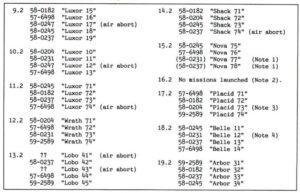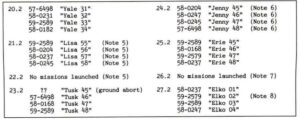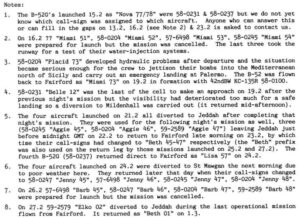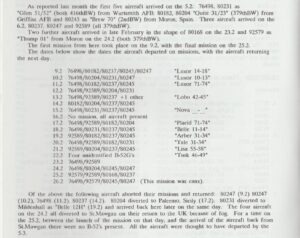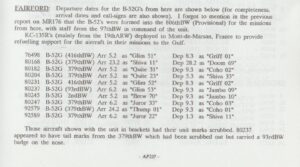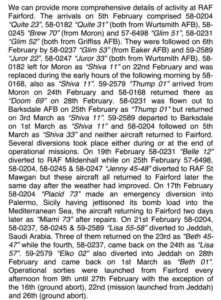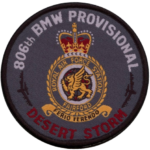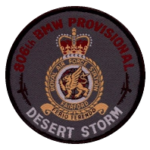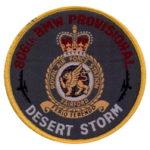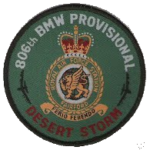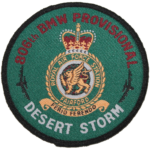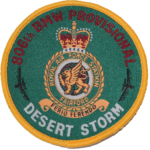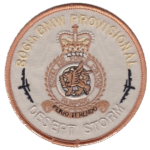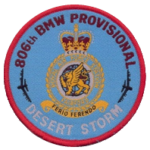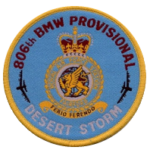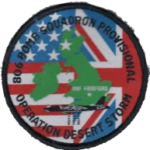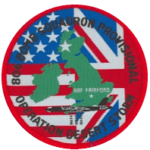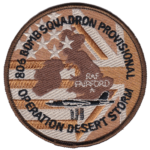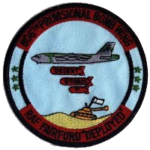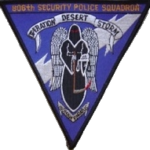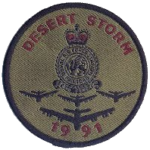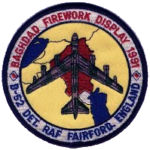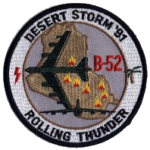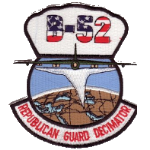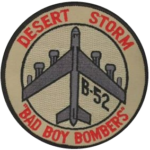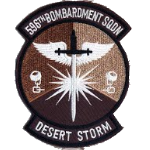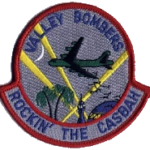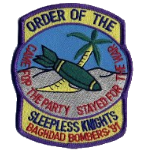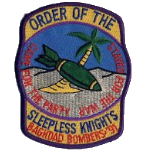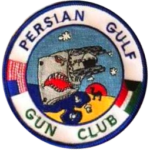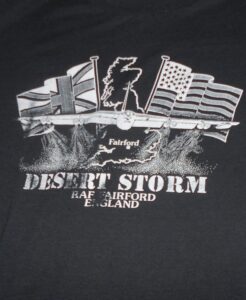OP DESERT STORM
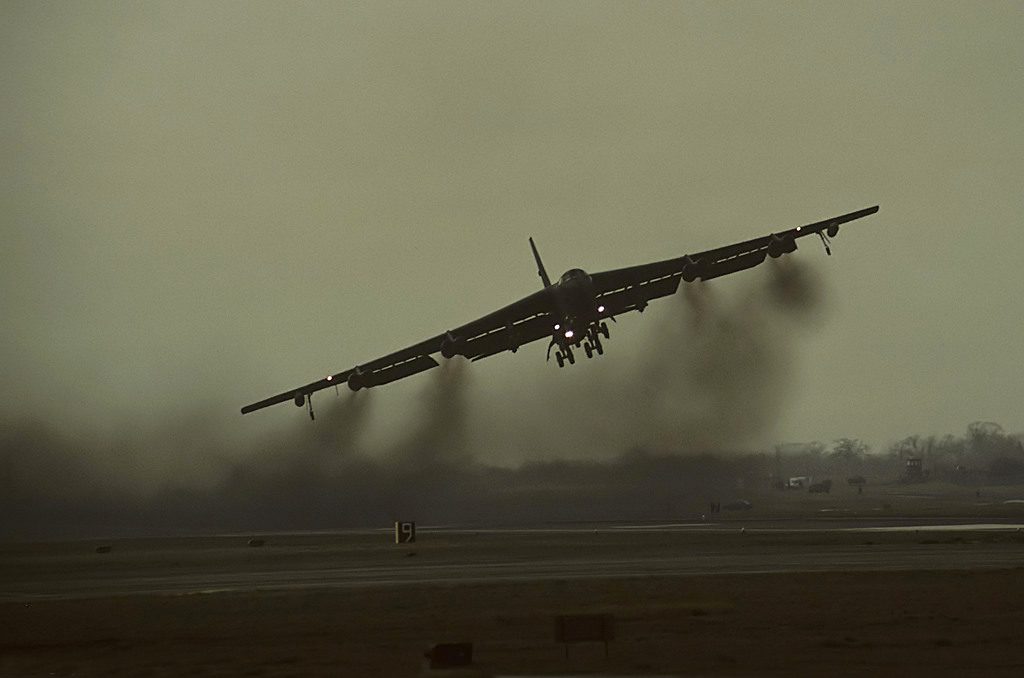
by Stuart Freer – Touchdown Aviation
The smallest and shortest lived of the four B-52G equipped provisional bomb wings was the 806th BW(P) at RAF Fairford, allocated to Strategic Air Command’s 7th Air Division at Ramstein AB, Germany.
Hastily created when it became clear that France would allow British based ‘Buffs’ to overfly its territory, the unit was formed around a cadre provided by the 97th BW from Eaker AFB and was commanded by the 97th BW / 340th BS boss Col George I Conlan. The 340th BS only had MACR radar jets so the decision was made to use other bases strategic radar jets to reduce the logistics train in the AOR. While the jets were from other bases the majority of the crews were 340th BS / 97th BW.
Other aircraft and aircrew for the Fairford detachment were drawn from the 524th BS/379th BW at Wurtsmith AFB, the 668th BS/416th BW at Griffiss AFB, the 62nd BS/2nd BW at Barksdale AFB and the 328th BS/93rd BW at Castle AFB. The first B-52G for the new wing arrived at Fairford on 5 February – the day the new unit was designated the 806th BW(P).
The wing had eight Primary Aircraft Authorised, although once again the official figures did not add up, detailing one jet from the 2nd BW, one from the 93rd, six from the 379th and two from the 416th. Ten B-52s actually deployed to Fairford (not simultaneously), two from the 2nd BW, six from the 379th and two from the 416th. All the Fairford aircraft were intended to be ‘777’ jets (JCSMS conventional aircraft), although in the event all were Cruise Missile Integrated.
Some 2000 tons of munitions arrived at Fairford from 6 February, 1158 tons of which would eventually be expended. The wing dropped 3008 of the 72,289 weapons expended by B-52Gs, comprising 2193 M117s, 560 MK82s, and 255 CBU-71/87/89s.
The wing became operational on 8 February. The first mission, using the call-sign ‘Luxor’, was launched the very next day, with three and four ship formations (with initially an extra ‘air spare’) being dispatched daily until 27 February, except on 16 February and 26 February when the missions were ‘scrubbed’. On 22 February the 806th BW(P)’s mission was launched from Jeddah, where the wing’s four ship cell of aircraft had diverted the day before.
Generally speaking, the missions proved straightforward and the B-52s serviceability was exemplary. The mission turnaround time pre-war had generally hovered around the 5.5 hour mark, but 90 minute turnarounds became routine at Fairford during the war. When the average sortie time was 16.3 hours, rapid turnarounds were essential.
There were however a handful of incidents. On 17 February for example 58-0204 ‘Special Delivery’ operating as ‘Placid 73’ suffered major hydraulic problems en route to the target. The captain was forced to jettison his bomb load into the Mediterranean, before diverting to Palermo. The aircraft returned to Fairford on 19 February. Despite unusually severe weather, which occasionally sprinkled Fairford with snow, there were relatively few weather diversions. Single aircraft diverted to Mildenhall (58-0231 High Roller on 18 February) and Jeddah (59-2579 on 27 February) and all four aircraft of ‘Jenny’ flight diverted to St Mawgan on 24 February. The wings designated weather / refueling diversions at Istres Le Tube and Malpensa (Milan) were not used ‘in anger’.
The B-52Gs of the ‘Royal Gloucestershire Air Force’ left Fairford between 1 and 9 March, having flown 62 sorties totalling 927.4 combat flying hours (some sources suggest that the hours total was rather higher, at 975.7 hours).
The Stratofortress’s stationed furthest from their targets tied up a disproportionate number of the USAF’s tankers and the 806th’s B-52Gs used aircraft from the 807th AREFS(P) at Mont de Marsan and the 803rd AREFS(P) at Athens-Hellenikon.
‘B-52 Stratofortress Units In Operation Desert Storm’ Jon Lake – Osprey Combat Aircraft 50
Thames Valley Aviation Society – Centreline May / Jun 1991 report
https://www.raf-fairford.co.uk/wp-content/uploads/2023/10/806th-TVAS-Centreline.pdf
MAY 1991 BARG PROVIDED DETAILS OF ALL operational FLIGHTS UNDERTAKEN BY THE 806TH BW(P) AT RAF FAIRFORD
Update – On 13.2 58-0231 was “Lobo 31” & 58-0245 was “Lobo 43”
‘AIR’ THE JOURNAL OF WEST LONDON AVIATION GROUP ALSO PUBLISHED DETAILS OF FLIGHTS IN THEIR MARCH & APRIL 1991 EDITIONS
BARG lists the callsigns for the 1st mission as Luxor 15 – 19, whereas AIR lists them as Luxor 14 – 18. Thanks to Graham Luxton he confirms BARG is correct. Originally, the mission was “LUXOR 15 – 18” but became “15 – 19” when the spare was launched.
‘Aeromilitaria SPRING 2007’ published details on sorties per aircraft and flights
SAC 7th Air Division commanded deployed Air Refueling and B-52 Stratofortress Bombardment Wings located outside of the CENTAF AOR
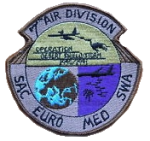
806th BW(P)
Grey with Black Edge
WANT
Grey with Black Edge
WANT
Grey with Yellow Edge
WANT
Green with Black Edge
Green with Black Edge
Green with Yellow Edge
Desert Colour
WANT
Blue with Red Edge
Blue with Yellow Edge
Provisional Black Edge
Provisional Red Edge
Provisional Desert
WANT
RAF Fairford Deployed
Other Fairford / 806th Patches
Firework Display 1991
Rolling Thunder
Republican Guard Decimator
Bad Boy Bombers
596th Bomb Squadron
328th Bomb Squadron
Rockin The Casbah
668th Bomb Squadron
62nd Bomb Squadron

